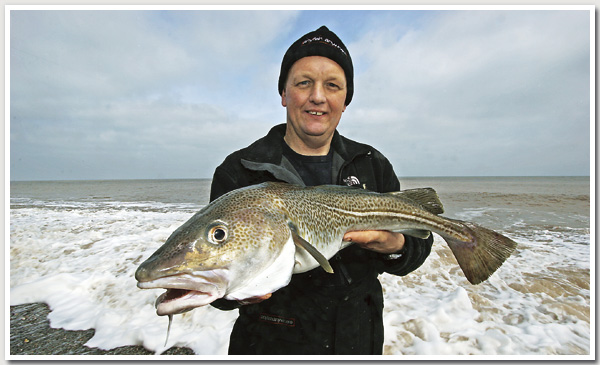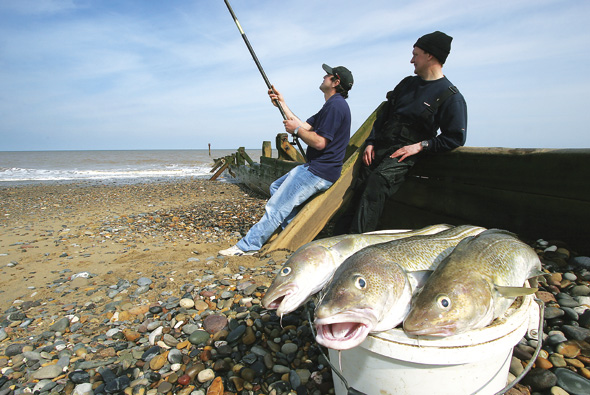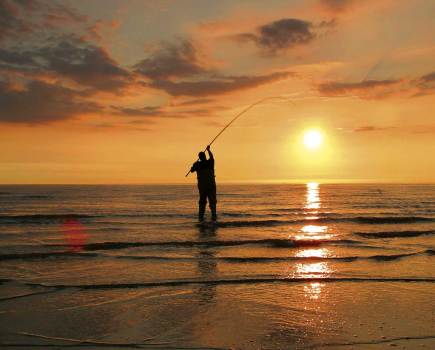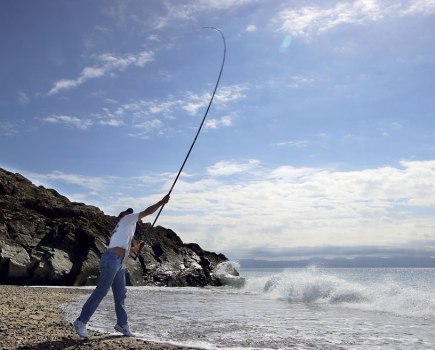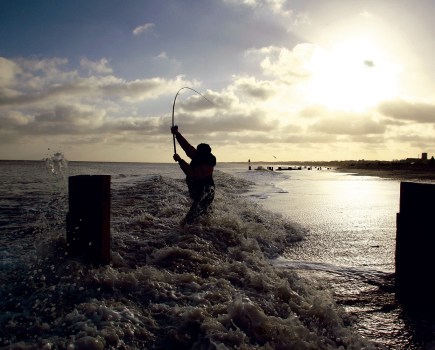“You’re looking at cod, rays, whiting, flounders, pouting, dogfish and a few bass,” local match angler George Smith confirms. “We get a good run of spring cod every year but the fish vary in weight, plus there’s the odd scattering of dogfish too.”
All of them biding their time…
According to Hull University’s Geography Department, few coastlines anywhere on the planet are disappearing as quickly as this one. The soft boulder clay cliffs left behind by the retreating ice sheet 12,000 years ago are at the mercy of North Sea breakers and currently slim down at a rate of between one and three metres a year, necessitating a sea defence programme that currently accounts for almost seven miles of this crumbling shoreline in East Yorkshire.
As the old Irving Berlin song goes, with a slight alteration, however, “There may be trouble ahead, but while there’s moonlight and music and love and romance, let’s face the music and fish.”
That’s probably not quite how George Smith puts it, but while the waves that bring ruin also happen to be bringing fish, he and pal Karl Nangle could be forgiven for focusing on the short-term when they tried their luck at Hilston and Withernsea, two marks typical of the 15-mile Holderness coastline that separates Skipsea and Spurn Head.
 Spring fever
Spring fever
“YOU have to take care with the cliffs, especially if you’re an older angler,” Smith warns. “Local anglers have cut paths into most of them but, being clay, they can be treacherous if it has been raining.”
If you can get down to the beaches safely, though, then the fishing is year-round, although it is the spring run that offers the greatest variety.
“In winter, there are cod and pouting, with dabs and flounders in calm weather,” says George. “The summer fishing is for dogfish and rays and you stand a chance of a bass throughout the year. In spring, though, you never know what you might catch.
“You can get bags of 30-40lb at that time of year. Rays and cod go to 10lb and bass to 6lb.”
The coastline can be fished day or night and on any tide, although the size of tides varies either side of Hilston. “You get the bigger tides north of there than those between Hilston and Spurn to the south,” Smith points out. “You get the advantage of more movement in the water on the bigger tides, but if they are too big you can get pushed back onto the cliffs. Normally, the beaches fish right up to high water.”
Best after the wind has been blowing, the Holderness coast will fish from low water up to high and a little way back down again. The terrain is shingle, giving way to sand with patches of clay, and is striped with sandbars and gullies, the precise layout of which can be inspected at low water.
“The fish tend to occupy bands of water and your initial casts should be to different distances, so you can discover how far out today’s band is,” George maintains. His own tactic is to fish two rods, one working the sub-100yd range while the other explores deeper waters.
Karl will bag a 4lb 8oz codling within 10 yards of the shore on this occasion and George adds that this can make it a good mark for anyone who would like to fish lighter than usual.
“It means you can get by with a two- or three-hook flapper and save your clipped-down rigs for more long-range work. For the pleasure angler who’s after a big fish and fishing at different distances, I would recommend a size 2/0 hook on a 25lb snood. I like my snoods long to promote more movement in the water.
“I use 18lb Ultima F1 Black mainline with a decent shockleader and a lead weight of 4-6oz will handle the kind of tides you get here. Be as light as you can with your lead when fishing close in, so that it rolls around a lot and keep an eye on your rod because it could get dragged in by a fish that close.”

Squid’s in
Bait for the spring season consists of ragworms, lugworms, crabs and squid, with the latter a big plus at a time of year when the coast enjoys a run of squid and cuttlefish that the larger predators seize upon with relish. Fish it on its own or use it in a cocktail with worms or crabs. Bring your own worms, though, as the shoreline fishes much better than it digs.
“There aren’t too many crabs around to strip your bait in the spring, so you can leave about 20 minutes between casts,” says Smith. “In the summer, you need to re-bait more regularly.”
If you want rays, he recommends that you wait for a calm day with any breeze coming from the west. Dogfish also show in calmer conditions, while cod and bass seem oblivious to the weather conditions.
One final word of advice for the casual angler: if you are looking to take your pick of the Holderness marks, it may be advisable to take a day off during the week.
“All the matches in the area tend to be rovers and places like Hilston, Holmpton and Hornsea’s north beach get busy at weekends,” George, an England shore angler, advises.
Otherwise, the place is all yours. Enjoy it while it lasts.
